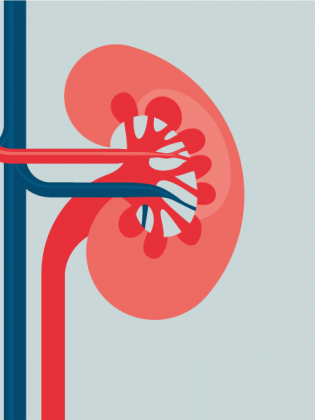Angiomyolipoma
What is angiomyolipoma?
What should I know about angiomyolipoma?
Angiomyolipomas are benign tumors (hamartoma) made up of blood vessels, muscle cells and fat cells. They account for 1% to 3% of solid kidney tumors, and come in two forms:
- Sporadic: the most frequent. This form appears randomly, usually as a single tumor, with no link to specific genetic factors.
- Hereditary: some people inherit a genetic predisposition to developing angiomyolipomas, combined with other hereditary conditions such as tuberous sclerosis (Bourneville disease) or Cowden syndrome. These tumors can be multiple and grow in both kidneys, requiring more complex care.
Angiomyolipomas are non-cancerous. Nevertheless, they can lead to complications if they grow in size or cause internal bleeding. A specific evaluation and appropriate medical surveillance are essential for managing this condition.

What are the symptoms of angiomyolipoma?
Angiomyolipomas are often silent, with no visible symptoms. They can be discovered by chance, during medical exams performed for another reason. However, when these tumors become too large, they can compress neighboring organs and cause chronic abdominal and/or back pain. They can also manifest as a palpable mass in the abdomen.
There is a also risk of spontaneous hemorrhage. While this complication is very rare, it requires urgent medical care. The following symptoms should alert you:
- Acute abdominal pain
- Hematuria (blood in the urine)
- Hypertension (high blood pressure)
What are the risk factors and causes of angiomyolipoma?
In most cases, there are no risk factors. The exact cause of angiomyolipomas is not always totally clear. Various factors and conditions are associated with their development. Possible risk factors and causes include:
- Tuberous sclerosis (TS), also known as Bourneville disease: a rare genetic disease that stimulates the development of angiomyolipomas. Patients with TS frequently present with multiple angiomyolipomas affecting both kidneys.
- Associated genetic syndromes: Angiomyolipomas may be linked to other genetic diseases, such as Cowden syndrome.
- Feminine gender: statistics show that women are more likely than men to develop angiomyolipomas. This increased prevalence in women suggests that hormones may influence the growth of these tumors.
It should be noted that even if you have these risk factors, this does not mean you will necessarily develop an angiomyolipoma. Each case is unique, and an individual assessment must be performed to monitor and manage the situation as needed.
How are angiomyolipomas diagnosed at the American Hospital of Paris?
Angiomyolipomas are diagnosed using imaging exams that make it possible to view the tumor and accurately determine its location:
- Abdominal ultrasound: to determine the presence and size of the tumors
- Magnetic resonance imaging (MRI): to obtain detailed images of the tumor and evaluate its tissue composition
- Computed tomography scan (CT scan): to obtain precise information on the size and structure of the angiomyolipoma
If any uncertainty remains about the nature of the tumor, exploratory surgery is performed combined with a biopsy to determine whether it is benign or malignant and offer the appropriate treatment plan.
What treatment options are available for angiomyolipoma at the American Hospital of Paris?
The treatment options for angiomyolipoma depend on factors such as the tumor’s size, the symptoms and potential complications. The techniques vary depending on whether the tumor is bleeding, growing or spreading to a nearby organ.
If the tumor is less than 4 cm in diameter and isn’t causing any symptoms, we recommend undergoing regular imaging surveillance.
Beyond 4 cm, the different treatments for angiomyolipoma include:
- Embolization: this minimally invasive procedure consists in blocking the blood vessels that supply the tumor. This reduces the tumor's volume and the risk of bleeding, eventually causing the tumor to disappear.
- Cryoablation: this minimally invasive technique consists in applying extreme cold to eliminate the angiomyolipoma.
- Ablation surgery (lumpectomy, partial or total nephrectomy): this surgical procedure consists in the removal of the tumor and partial or complete removal of the kidney.
The technique is chosen based on your personal situation. At the American Hospital of Paris, our medical team uses a personalized approach, working collaboratively to provide the best possible treatment based on your situation. Our aim is to improve your quality of life. If you are concerned or experiencing any symptoms, feel free to contact us for an in-depth medical assessment.
Learn more about angiomyolipoma embolization
Learn morekey figures
-
0,2 à 0,6%
Prevalence of angiomyolipomas, with a strong predominance in women.
https://www.ncbi.nlm.nih.gov/pmc/articles/PMC6032655/
-
1 à 3%
The proportion of angiomyolipomas among solid kidney tumors.
Source: https://www.ncbi.nlm.nih.gov/pmc/articles/PMC4345224/
